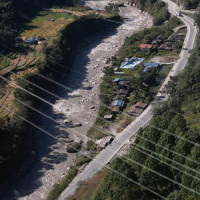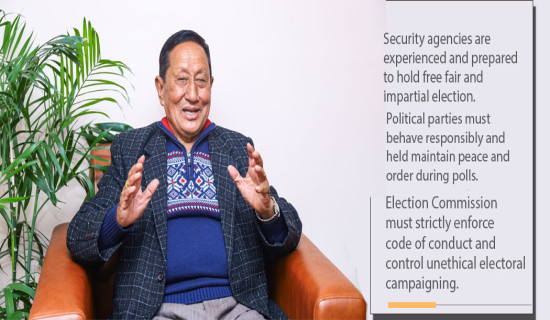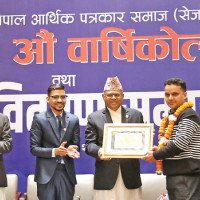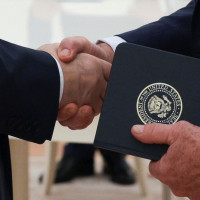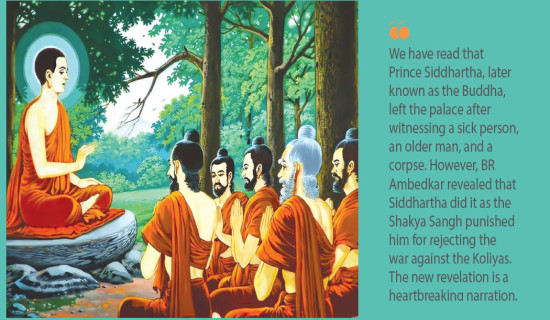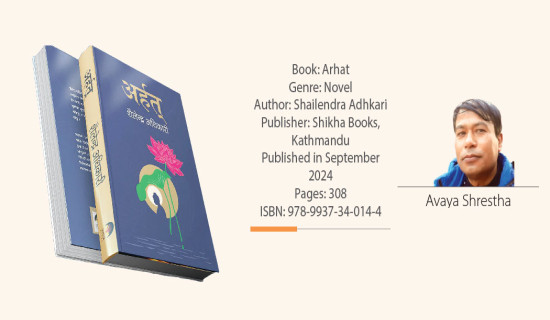- Tuesday, 2 December 2025
Constitution Ensures Cultural Continuity
Two weeks ago, the Kathmandu Valley came alive with the celebration of the Indrajatra Festival. The festival once again revived the centuries-old traditions of Kathmandu's old city corners like Indrachowk, Hanumandhoka, Marutole, Basantapur, Kilagal, Naradevi, and Jaisidewal. The sight of chariots rolling down the streets and the Lakhe and Jhyalincha performing their theatrical dances made it feel like the entire city, usually absorbed in business and commerce, had risen from its daily snooze. The procession of the 'living goddess' Kumari, the 'living deities' Bhairav and Ganesh, the resonant beats of the Dime drums, and the festivities at the courtyards of Aju Dya (Aakash Bhairav) and Hathu Dya (Swet Bhairav) captured everyone's attention.
Culture expert Padmasundar Joshi considers the festivals of Kathmandu Valley unparalleled. "Compared to our Indrajatra and Bisket Jatra, even the street parades of Rome and Italy, the carnivals of Brazil, or Japan's Hakata Festival seem pale," Joshi writes in one of his articles. "Our festivals not only showcase artistic excellence but also reveal profound philosophies of life." Another major highlight of Indrajatra is Hathu Hayekegu, the ritual of drinking Jaand (traditional rice beer) as prasad from the spout attached to the mouth of the idol of Hathu Dya. The belief that drinking it keeps one healthy and fit draws many enthusiastic youths. Indrajatra is celebrated for eight days, from Yalathwa Dwadashi to Yalaga Chaturthi, on the Nepal Sambat calendar.
For the past decade, one day has been reserved exclusively for women to partake in the Hathu Hayekegu ritual, and their enthusiastic participation is remarkable. In fact, for the last ten years, women have also been pulling the chariots of Kumari, Ganesh, and Bhairav for one day. In the beginning, there was a shortage of women willing to pull the chariots, but now getting a turn to hold the ropes has become difficult. Today, nearly every festival witnesses participation from the concerned and other communities, demonstrating a strong sense of social harmony. This growing enthusiasm can easily be felt, especially after the promulgation of Nepal's Constitution-2015 (2072 BS).
Whether it is Lhosar of the Tamang, Gurung, and Sherpa communities, Ubhauli–Udhauli of the Rai, Chasok Tangnam of the Limbu, or Maghi of the Tharu, every celebration now sees vigorous participation from its community members. Their traditional attire adds a unique vibrance to the festivities.
Kathmandu is not just the political capital of Nepal but also a melting pot of cultures. Here, one can witness almost every major festival celebrated across the country. During the Deuda dance performance at Tundikhel on the occasion of the Gaura Parva, even top political leaders join hands with the public, keeping the culture of the Khas Arya community of Sudur Paschim Province alive. The city also embraces the grandeur of Chhath with equal fervour.
The Newar community's numerous festivals invigorated the Kathmandu Valley throughout the year. Almost every festival features processions of girls in traditional Haku-Patasi (black skirt with red border), accompanied by Dhime drums and flute music, filling every street and alley. Nowadays, the girls wearing Haku-Patasi are not just Newars; young women from other communities also join in and are warmly welcomed.
Nepal's Constitution-2015 has enshrined cultural rights as fundamental rights, helping establish Nepal as a multicultural nation. According to Suresh Kiran Manandhar, a member of the Language Commission and a culture activist, the current constitution is more progressive regarding language, culture, and community rights than its predecessors. It has devolved greater authority to local-level governments rather than just provincial ones. "The responsibility of protecting language, culture, and art lies with the local governments," Manandhar explains. "With powers to collect taxes and formulate budgets, these local bodies have begun allocating compulsory funds for cultural preservation." Manandhar also observes that a significant portion of the funds allocated through the MPs' Development Fund is now being utilised for cultural activities, giving the impression of a genuine cultural revival. Writer Amar Giri's opinion does not differ from Manandhar's.
Identitarian writer Rajendra Maharjan also agrees with Manandhar. "There is a sudden surge of pride in identity and culture," says Maharjan, the conceptualiser of the Naya Nepal pages in the Gorkhapatra Daily. "Enthusiasm is clearly visible in the performances, but it is equally important that communities remain vigilant so their identity issues are not diluted." The experience of noted Tharu writer Krishna Raj Sarbahari echoes Maharjan's view. "Indigenous communities, who once voiced their concerns timidly, now raise them openly," cultural activist Ganesh Ram Lachi observes. "The constitution provides this right." The cultural renaissance began with the restoration of democracy in 1990 (2046 BS). The momentum has increased dramatically after the People's Movement of 2006 (2062–63 BS) and the promulgation of Nepal's Constitution-2015. According to identitarian writer Kumari Lama, indigenous groups have now started gathering in public spaces during festivals and putting on grand displays. "But it is necessary to remain alert to the fact that the essence of culture is in danger of being swallowed by commercial forces," Lama warns. Madhesi writer and chairperson of the Language Commission, Gopal Thakur, believes the constitution has fuelled enthusiasm for cultural festivals and driven cultural transformation. "The constitution's recognition of multiple languages, cultures, and identities is a major shift," Thakur says. "It's guaranteed that everyone is equal, which has significantly boosted the morale of Dalits and other marginalised communities."
Thakur's statement can also be linked to mother-tongue rights. The Supreme Court had nullified decisions of Kathmandu Metropolitan City to recognise Nepal Bhasha and of Dhanusha and Rajbiraj municipalities to recognise Maithili as working languages on May 31, 1999 (2056 Jestha 18). Since then, the Newar community has been marking that date annually as a Black Day to protest the denial of their linguistic rights. After the 2015 constitution, the Bagmati Province government passed and implemented the Government's Official Language Act 2080, recognising Nepal Bhasha and Tamang as official languages. This brought an end to the Black Day protests. Other provinces are now also moving towards enacting similar laws. Constitutional rights have indeed brought about a cultural resurgence. Yet, it must be considered that culture should serve to make human civilisation more beautiful, civilised, humane, and compassionate. The responsibility to keep traditions scientific and progressive, and not allow them to become regressive, lies primarily with the communities themselves.
(Litterateur Shrestha writes a column on miscellaneous issues.)





